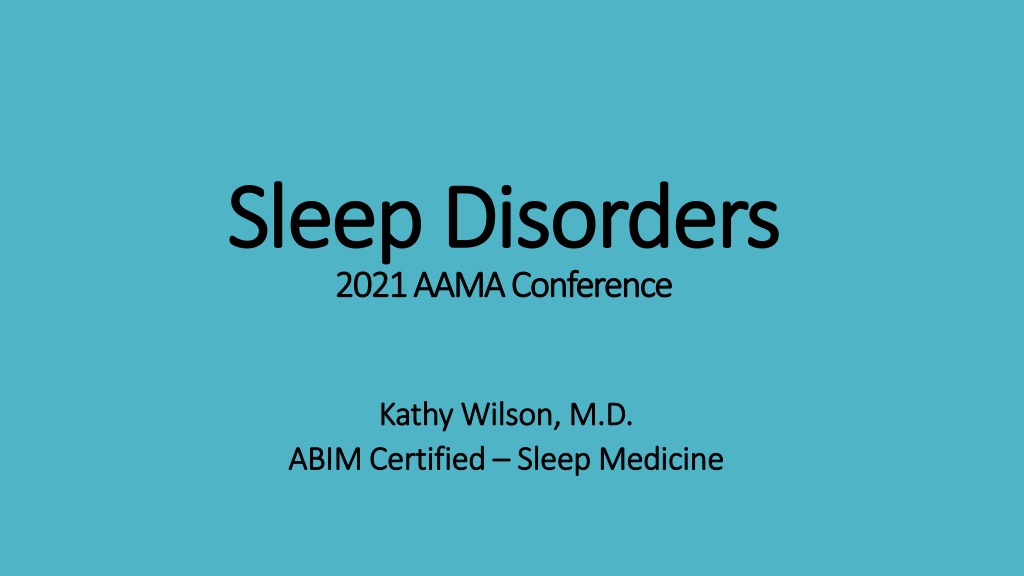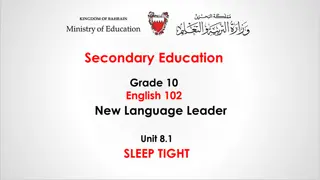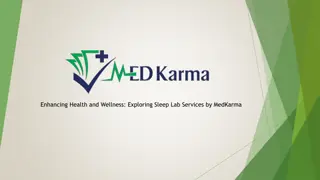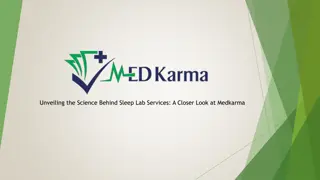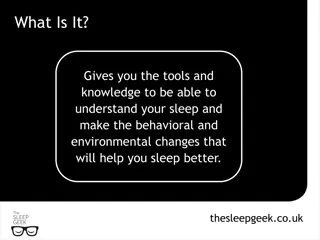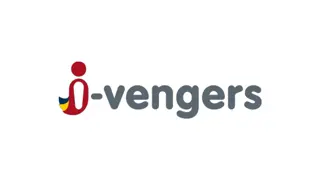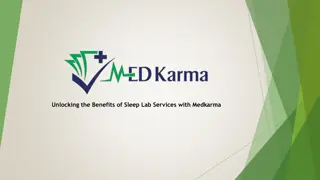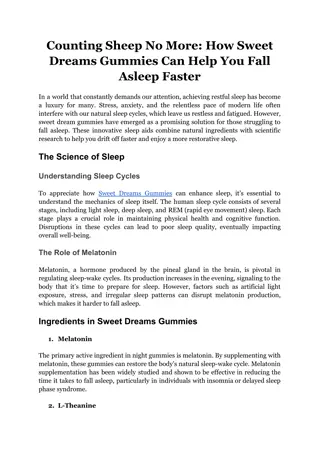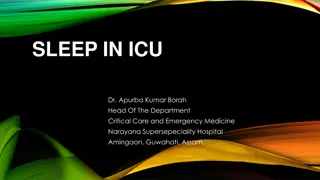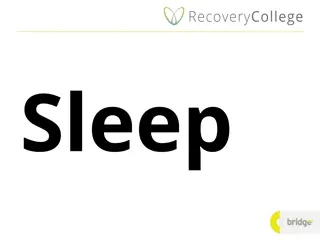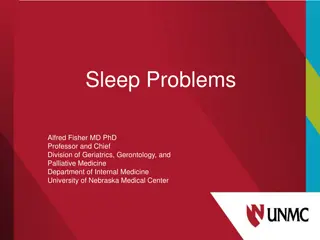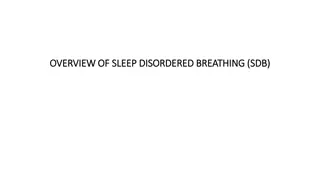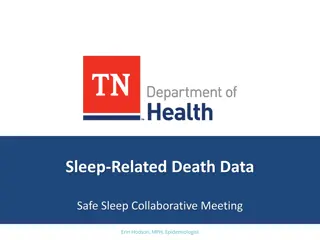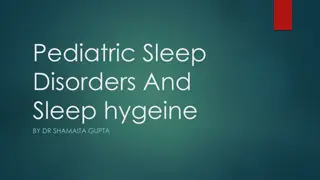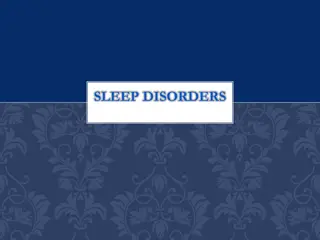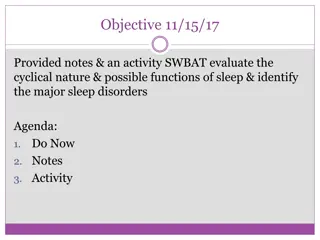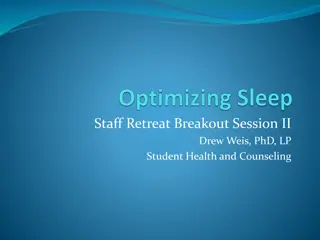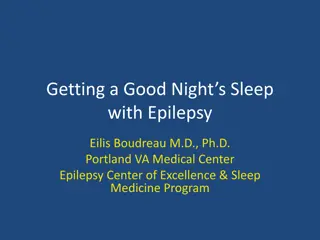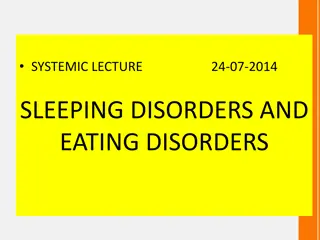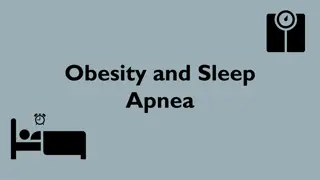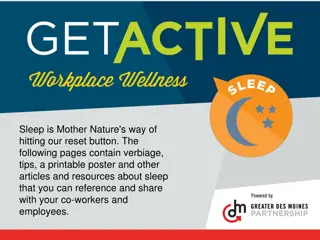Understanding Sleep Disorders: Classification and Diagnosis
Sleep disorders encompass various conditions affecting sleep patterns and quality. They are classified into categories such as insomnia, sleep-related breathing disorders, central disorders of hypersomnolence, circadian rhythm sleep-wake disorders, parasomnias, and sleep-related movement disorders. Sleep studies, including in-lab polysomnography and home sleep tests, play vital roles in diagnosing disorders like obstructive sleep apnea. Chronic insomnia, characterized by difficulties initiating and maintaining sleep, is a common disorder that can impact daily functions and overall well-being.
Download Presentation

Please find below an Image/Link to download the presentation.
The content on the website is provided AS IS for your information and personal use only. It may not be sold, licensed, or shared on other websites without obtaining consent from the author. Download presentation by click this link. If you encounter any issues during the download, it is possible that the publisher has removed the file from their server.
E N D
Presentation Transcript
Sleep Disorders Sleep Disorders 2021 AAMA Conference 2021 AAMA Conference Kathy Wilson, M.D. Kathy Wilson, M.D. ABIM Certified ABIM Certified Sleep Medicine Sleep Medicine
7 classifications of Sleep Disorders 1. 1. Insomnia disorders Insomnia disorders 2. 2. Sleep related breathing disorders Sleep related breathing disorders 3. 3. Central disorders of hypersomnolence Central disorders of hypersomnolence 4. 4. Circadian rhythm sleep Circadian rhythm sleep- -wake disorders wake disorders 5. 5. Parasomnias Parasomnias 6. 6. Sleep related movement disorders Sleep related movement disorders
Sleep Studies Also called polysomnography Also called polysomnography In In- -lab sleep studies lab sleep studies 13 channels of data a. Considered the gold standard a. Considered the gold standard 13 channels of data Home sleep studies Home sleep studies 3 or 4 channels of data 3 or 4 channels of data a. Home sleep studies can only be used to diagnose a. Home sleep studies can only be used to diagnose obstructive b. Up to 25% can be falsely normal b. Up to 25% can be falsely normal c. A normal home sleep test does not necessarily mean there is no OSA c. A normal home sleep test does not necessarily mean there is no OSA obstructive sleep apnea sleep apnea
Insomnia Disorders 1. Chronic insomnia 1. Chronic insomnia 2. Short 2. Short- -term insomnia term insomnia No sleep study is needed to diagnose insomnia No sleep study is needed to diagnose insomnia
Insomnia Disorders 1. Chronic insomnia . Chronic insomnia a. a. Difficulty initiating sleep Difficulty initiating sleep Difficulty maintaining sleep (numerous or lengthy awakenings) Difficulty maintaining sleep (numerous or lengthy awakenings) Waking up earlier than desired (and can t go back to sleep) Waking up earlier than desired (and can t go back to sleep) Resistance to going to bed on an appropriate schedule Resistance to going to bed on an appropriate schedule Difficulty sleeping without parent or caregiver intervention Difficulty sleeping without parent or caregiver intervention b. Symptoms must be present b. Symptoms must be present Fatigue, daytime sleepiness, memory impairment, mood disturbance, impaired Fatigue, daytime sleepiness, memory impairment, mood disturbance, impaired performance performance Attention impairment, behavioral problems Attention impairment, behavioral problems
Insomnia Disorders 1. 1. Chronic insomnia Chronic insomnia c. The problem can t be explained purely by inadequate opportunity for sleep c. The problem can t be explained purely by inadequate opportunity for sleep d. The problem must occur at least 3 times a week d. The problem must occur at least 3 times a week e. The problem must be present for at least 3 months e. The problem must be present for at least 3 months f. The problem is not better explained by another sleep or other medical disorder f. The problem is not better explained by another sleep or other medical disorder 2. Short 2. Short- -term insomnia term insomnia same criteria as chronic but for less than 3 months same criteria as chronic but for less than 3 months
Insomnia Disorders Treatment of insomnia Treatment of insomnia a. a. Various medications Various medications b. b. Cognitive Behavioral Therapy for Insomnia (CBT Cognitive Behavioral Therapy for Insomnia (CBT- -i i) ) - -In person by a trained PhD psychologist In person by a trained PhD psychologist - -Online programs Online programs
Sleep Related Breathing Disorders 1. Obstructive sleep apnea 1. Obstructive sleep apnea 2. Central sleep apnea 2. Central sleep apnea 3. Sleep 3. Sleep- -related hypoventilation related hypoventilation 4. Sleep 4. Sleep- -related hypoxemia related hypoxemia 5. Other 5. Other A sleep study is needed to diagnose all sleep related breathing disorders. A sleep study is needed to diagnose all sleep related breathing disorders.
Sleep Related Breathing Disorders 1. Obstructive sleep apnea 1. Obstructive sleep apnea the airway is blocked (obstructed) during sleep the airway is blocked (obstructed) during sleep a. Apnea a. Apnea b. Hypopnea b. Hypopnea c. Apnea c. Apnea- -Hypopnea Index (AHI) Hypopnea Index (AHI) Mild OSA Mild OSA AHI from 5 to 14.9 (treatment is optional) AHI from 5 to 14.9 (treatment is optional) Moderate OSA Moderate OSA AHI from 15 to 29.9 AHI from 15 to 29.9 Severe OSA Severe OSA AHI of 30 and above AHI of 30 and above Pediatric OSA Pediatric OSA AHI of 1.0 or more (0 AHI of 1.0 or more (0 17 years old) 17 years old)
Sleep Related Breathing Disorders 1. Obstructive sleep apnea 1. Obstructive sleep apnea Screening: Epworth Sleepiness Scale, STOP Screening: Epworth Sleepiness Scale, STOP- -BANG BANG Consequences: daytime sleepiness, fatigue, hypertension, arrhythmias, fatigue Consequences: daytime sleepiness, fatigue, hypertension, arrhythmias, fatigue- -related accidents, stroke, headaches, low testosterone, high red blood cell count, etc., etc., etc. accidents, stroke, headaches, low testosterone, high red blood cell count, etc., etc., etc. related Treatment Treatment a. Positive airway pressure (CPAP, APAP, BiPAP, ASV) a. Positive airway pressure (CPAP, APAP, BiPAP, ASV) b. Oral appliance therapy b. Oral appliance therapy c. Surgical interventions c. Surgical interventions upper airway surgery, hypoglossal nerve stimulation upper airway surgery, hypoglossal nerve stimulation d. Pediatric OSA treatment d. Pediatric OSA treatment tonsillectomy unless already done tonsillectomy unless already done
Sleep Related Breathing Disorders 2. Central sleep apnea 2. Central sleep apnea absent or reduced respiratory drive absent or reduced respiratory drive a. Disorder of CO2 receptors a. Disorder of CO2 receptors b. Opioid b. Opioid- -induced induced c. High altitude c. High altitude d. Treatment d. Treatment- -emergent emergent e. Can happen in infancy e. Can happen in infancy different than SIDS and ALTE different than SIDS and ALTE Treatment: CPAP, BiPAP, ASV Treatment: CPAP, BiPAP, ASV
Sleep Related Breathing Disorders 3. Sleep related hypoventilation disorders 3. Sleep related hypoventilation disorders - -Obesity hypoventilation syndrome Obesity hypoventilation syndrome - -Due to medication or substance Due to medication or substance - -Due to a medical disorder (lung, neurologic, skeletal) Due to a medical disorder (lung, neurologic, skeletal) 4. 4. Sleep related Hypoxemia disorder Sleep related Hypoxemia disorder always due to another problem always due to another problem 5. 5. Other Other Snoring Snoring Catathrenia Catathrenia
Disorders of Central Hypersomnolence 1. Narcolepsy 1. Narcolepsy 2. Idiopathic hypersomnia 2. Idiopathic hypersomnia 3. Kleine 3. Kleine- -Levin Syndrome Levin Syndrome 4. Hypersomnia due to a medical disorder 4. Hypersomnia due to a medical disorder 5. Hypersomnia due to a medication or substance 5. Hypersomnia due to a medication or substance 6. Hypersomnia associated with a psychiatric disorder 6. Hypersomnia associated with a psychiatric disorder 7. Insufficient sleep syndrome 7. Insufficient sleep syndrome A sleep study is needed to diagnose disorders of central hypersomnolence A sleep study is needed to diagnose disorders of central hypersomnolence
Central disorders of hypersomnolence 1. Narcolepsy 1. Narcolepsy irrepressible need to sleep or daytime lapses into sleep irrepressible need to sleep or daytime lapses into sleep a. Type 1: cataplexy must be present OR a low orexin/hypocretin level in the spinal fluid a. Type 1: cataplexy must be present OR a low orexin/hypocretin level in the spinal fluid b. Type 2: no cataplexy; orexin hypocretin level is normal or has not been checked b. Type 2: no cataplexy; orexin hypocretin level is normal or has not been checked Very specific sleep studies are needed Very specific sleep studies are needed - -Overnight study Overnight study must show absence of other sleep disorders must show absence of other sleep disorders - -Multiple Sleep Latency Test (MSLT) Multiple Sleep Latency Test (MSLT) must show REM sleep during 2 or more naps must show REM sleep during 2 or more naps 2. Idiopathic hypersomnia 2. Idiopathic hypersomnia Same symptoms as narcolepsy Same symptoms as narcolepsy Diagnostic criteria not met Diagnostic criteria not met Treatment of both: Medications that reduce sleepiness, sometimes sleep medication is needed Treatment of both: Medications that reduce sleepiness, sometimes sleep medication is needed
Central Disorders of Hypersomnolence 3. Kleine 3. Kleine- -Levin Syndrome Levin Syndrome 4. Hypersomnia due to a medical disorder 4. Hypersomnia due to a medical disorder - -Parkinson s disease, post Parkinson s disease, post- -traumatic, genetic disorders, brain tumors, infections, endocrine traumatic, genetic disorders, brain tumors, infections, endocrine - -Residual hypersomnia with adequately treated OSA Residual hypersomnia with adequately treated OSA 5 5. Hypersomnia due to a medication or substance . Hypersomnia due to a medication or substance 6. 6. Hypersomnia associated with a psychiatric disorder Hypersomnia associated with a psychiatric disorder 7. 7. Insufficient sleep syndrome Insufficient sleep syndrome
Circadian Rhythm Sleep-Wake Disorders 1. 1. Advanced Sleep Advanced Sleep- -Wake Phase Disorder Wake Phase Disorder 2. 2. Delayed Sleep Delayed Sleep- -Wake Phase Disorder Wake Phase Disorder 3. 3. Irregular Sleep Irregular Sleep- -Wake Phase Disorder Wake Phase Disorder 4. 4. Non Non- -24 Sleep 24 Sleep- -Wake Phase Disorder Wake Phase Disorder 5. 5. Shift Work Disorder Shift Work Disorder 6. 6. Jet Lag Jet Lag A sleep study is not needed to diagnose circadian rhythm disorders A sleep study is not needed to diagnose circadian rhythm disorders
Circadian Rhythm Sleep-Wake Disorders 1. 1. Advanced Sleep Advanced Sleep- -Wake Phase Disorder Wake Phase Disorder - - going to bed early and getting up early going to bed early and getting up early 2. 2. Delayed Sleep Delayed Sleep- -Wake Phase Disorder Wake Phase Disorder staying up late and sleeping late staying up late and sleeping late 3. 3. Irregular Sleep Irregular Sleep- -Wake Phase Disorder Wake Phase Disorder sleeping in small amounts around the clock sleeping in small amounts around the clock 4. 4. Non Non- -24 Sleep 24 Sleep- -Wake Phase Disorder Wake Phase Disorder most common in blind people most common in blind people Treatment: Timed melatonin, timed bright light, strict sleep/wake schedule Treatment: Timed melatonin, timed bright light, strict sleep/wake schedule
Circadian Rhythm Sleep-Wake Disorders 5. 5. Shift Work Disorder Shift Work Disorder a. A recurring work schedule that overlaps the usual time for sleep a. A recurring work schedule that overlaps the usual time for sleep b. Insomnia and/or excessive sleepiness b. Insomnia and/or excessive sleepiness c. Present for at least 3 months c. Present for at least 3 months d. Symptoms not better explained by some other sleep or medical disorder d. Symptoms not better explained by some other sleep or medical disorder Treatment Treatment Before shift: Bright light, medications that reduce sleepiness Before shift: Bright light, medications that reduce sleepiness After shift: Avoid bright light, sleep medications After shift: Avoid bright light, sleep medications
Circadian Rhythm Sleep-Wake Disorders 6. 6. Jet lag Jet lag a. Air travel across at least 2 time zones a. Air travel across at least 2 time zones b. Insomnia, excessive sleepiness, impairment in daytime function b. Insomnia, excessive sleepiness, impairment in daytime function c. Eastward travel to destinations with advanced times are more difficult to c. Eastward travel to destinations with advanced times are more difficult to adjust to than westward travel adjust to than westward travel Treatment: Timed melatonin, timed bright light, sleep medications, stay on home Treatment: Timed melatonin, timed bright light, sleep medications, stay on home schedule during the trip, medications that reduce sleepiness schedule during the trip, medications that reduce sleepiness
Parasomnias Undesirable physical events or experiences during sleep Undesirable physical events or experiences during sleep Almost all get worse when over Almost all get worse when over- -tired tired 1. 1. Non 2. 2. REM Related Parasomnias REM Related Parasomnias 3. 3. Other Parasomnias Other Parasomnias Non- -REM Related Parasomnias REM Related Parasomnias May or may not need a sleep study for diagnosis May or may not need a sleep study for diagnosis all are more common in people with other untreated sleep disorders, so a sleep study is usually done untreated sleep disorders, so a sleep study is usually done all are more common in people with other
Parasomnias 1. 1. Non Non- -REM Related Parasomnias REM Related Parasomnias a. Confusional arousals a. Confusional arousals absence of terror, does not get out of bed absence of terror, does not get out of bed b. Sleepwalking b. Sleepwalking out of bed out of bed c. Sleep terrors c. Sleep terrors abrupt terror, screaming, typically tachycardia and tachypnea abrupt terror, screaming, typically tachycardia and tachypnea d. Sleep related eating disorder d. Sleep related eating disorder requires being asleep or not remembering the eating requires being asleep or not remembering the eating
Parasomnias 2. 2. REM Related Parasomnias REM Related Parasomnias a. REM Sleep Behavior Disorder a. REM Sleep Behavior Disorder looks like acting out dreams, often violent looks like acting out dreams, often violent *Approximately 80% of people with RBD go eventually get diagnosed with a neurologic *Approximately 80% of people with RBD go eventually get diagnosed with a neurologic disorder such as Parkinson s disease disorder such as Parkinson s disease *Sleep study for diagnosis *Sleep study for diagnosis b. Recurrent Isolated Sleep Paralysis b. Recurrent Isolated Sleep Paralysis c. Nightmare Disorder c. Nightmare Disorder
Parasomnias 3. 3. Other Parasomnias Other Parasomnias a. Exploding Head Syndrome a. Exploding Head Syndrome a painless loud bang or explosion a painless loud bang or explosion b. Sleep Related Hallucinations b. Sleep Related Hallucinations c. Sleep enuresis c. Sleep enuresis bed wetting bed wetting *older than 5 *older than 5 *at least twice a week *at least twice a week *present for at least 3 months *present for at least 3 months *previously dry during sleep for at least 6 months *previously dry during sleep for at least 6 months d. Sleep talking d. Sleep talking not really a disorder unless it s very bothersome not really a disorder unless it s very bothersome
Sleep Related Movement Disorders 1. 1. Restless Leg Syndrome Restless Leg Syndrome 2. 2. Periodic Limb Movements of Sleep Periodic Limb Movements of Sleep 3. 3. Sleep Related Leg Cramps Sleep Related Leg Cramps 4. 4. Sleep Related Bruxism (clenching, grinding) Sleep Related Bruxism (clenching, grinding) 5. 5. Sleep Related Rhythmic Movement Disorder Sleep Related Rhythmic Movement Disorder PLM needs a sleep study to diagnose. The others do not. PLM needs a sleep study to diagnose. The others do not.
Sleep Related Movement Disorders 1. 1. Restless Leg Syndrome Restless Leg Syndrome an urge to move the legs, usually accompanied by an an urge to move the legs, usually accompanied by an uncomfortable or unpleasant sensation in the legs uncomfortable or unpleasant sensation in the legs a. Strict criteria for diagnosis a. Strict criteria for diagnosis b. You must be b. You must be awake c. Commonly caused by iron deficiency c. Commonly caused by iron deficiency d. Children can be misdiagnosed with ADD/ADHD d. Children can be misdiagnosed with ADD/ADHD e. Augmentation is a potential treatment complication e. Augmentation is a potential treatment complication awaketo have RLS to have RLS
Sleep Related Movement Disorders 2. 2. Periodic Limb Movements of Sleep Periodic Limb Movements of Sleep repetitive limb movements during sleep repetitive limb movements during sleep *You must be *You must be asleep asleep to have PLMs to have PLMs *Needs a sleep study to diagnose *Needs a sleep study to diagnose *Only needs treatment if it s bothersome *Only needs treatment if it s bothersome *Medications that treat also relieve restless leg syndrome *Medications that treat also relieve restless leg syndrome *PLMs are much more common than RLS *PLMs are much more common than RLS *Most people with PLMs do not have RLS but most people with RLS have PLMs *Most people with PLMs do not have RLS but most people with RLS have PLMs
Sleep Related Movement Disorders 3. 3. Sleep Related Leg Cramps Sleep Related Leg Cramps a. More common when PLMs are present a. More common when PLMs are present b. Same causes as daytime cramps b. Same causes as daytime cramps electrolytes, overuse, etc. electrolytes, overuse, etc. 4. 4. Sleep Related Bruxism Sleep Related Bruxism a. More common when OSA is present a. More common when OSA is present b. Common cause of morning headaches b. Common cause of morning headaches c. Treated with oral appliances and occasionally with muscle relaxers c. Treated with oral appliances and occasionally with muscle relaxers
Sleep Related Movement Disorders 5. 5. Sleep Related Rhythmic Movement Disorder Sleep Related Rhythmic Movement Disorder most typically in young children most typically in young children a. Rocking, head banging, head rolling, body rolling just before sleep a. Rocking, head banging, head rolling, body rolling just before sleep b. Must interfere with normal sleep or daytime function OR injury is occurring b. Must interfere with normal sleep or daytime function OR injury is occurring c. Must be distinguished from epilepsy c. Must be distinguished from epilepsy Normal Normal Sleep starts (hypnic jerks) Sleep starts (hypnic jerks) sudden brief jerks of the body just at sleep onset sudden brief jerks of the body just at sleep onset
Thank You! Q & A Q & A
